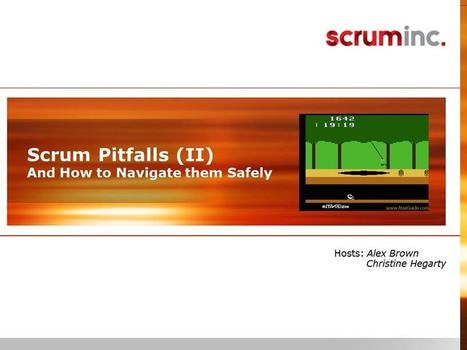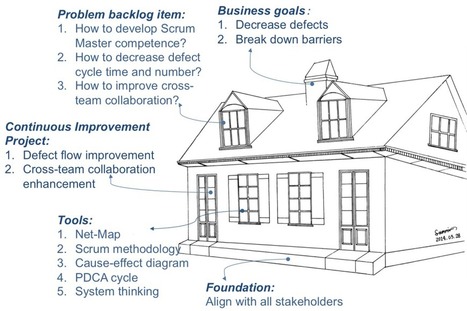 Your new post is loading...
 Your new post is loading...

|
Scooped by
Mickael Ruau
February 2, 2019 6:08 AM
|
Step 01: Master these Subjects for the certification
PSM Questions Checklist – Scrum Iteration:
What is a Iteration?
How it start and how it finishes on Scrum?
You must know the order for each event on the iteration, its purpose and how each event complements the scrum process toward the sprint goals.
Its is good to know too the impact if some team does not execute one of the Scrum Events.
What kind of problems the team will face due to that decision?
The lack of any event generate a pool of different problems in the project. You must know it.
Scrum Events
What are the Scrum Events?
You must know all the timeboxes, inputs and outputs from each event.
Who is mandatory to be on the event and who is opcional?
You must know too the objective of each member on the events.
PSM Questions Checklist – Scrum Reports
What are the reports on Scrum?
How does the Burning Down Charts are calculated?
Why reporting is so important to be done?
PSM Questions Checklist – Managing the Product Backlog
What is the Product Backlog?
Who should knows more about the business Goals?
Who should ordenate and get the business values of each Product Backlog Item?
Is there some techniques to ordenate the Product Backlog?
What can be added on the product backlog?
Who must administrate the Product Backlog?
An item can be added or removed during an Sprint that already started?
PSM Questions Checklist – Using Scrum Artefacts
What are then?
What is the purpose of each one?
Who generate each on then?
Who should be the most interested about the Artecfact´s transparency?
PSM Questions Checklist – The Scrum Players
Who are the Scrum Players?
How they interact with each one during the sprint?
What are theirs objectives and chalenges during the Sprint?
In the real life in which positions they are on Companies?
Is there a hierarchy among the scrum players?
How is the right size (number of members) of a development team?
And why the minimium and maximum quantity of people on the Development team?
What does it means?
PSM Questions Checklist – Why use Scrum?
Can we use scrum in any kind of project?
In which kind of projects the Scrum is more suitable, and why?
Why the scrum process helps the enterprise for achieving its goals?
Why the Customer should like more the Scrum process than the Waterfall process?
Scrum can be used in any industry?
PSM Questions Checklist – The Agile Manifesto
What is the Agile Manifesto?
When it was created and why?
What are the points mentioned on it and how each one can be used on the real life?

|
Scooped by
Mickael Ruau
January 28, 2019 9:10 AM
|
Multitasking is a form of wasted motion. Taiichi Ohno, in his book: The Toyota Production System outlined multiple forms of waste. Multitasking is a classic form of Muda, or wasted effort. It happens when people, systems or machines switch between contexts. Context switching has been heavily researched and pretty much every study shows that it creates large amounts of waste.

|
Scooped by
Mickael Ruau
January 28, 2019 12:42 AM
|
This experience report describes how a well-intentioned ‘mechanical’ implementation of scrum did not deliver on promise of agility, and why a Scrum Reboot with values has. It describes how a focus on the Scrum Values of Courage, Focus, Openness, Respect and Commitment provides the cultural environment necessary for success. Intralinks made the values real by focusing on seven principles of self-organization, 7 +/- 2 team size, done means done, empowered product owners, servant leader Scrum Masters, team ownership for adaption and the delivery of business value. And how the fundamental idea of inspection and adaption, a cornerstone for Scrum was made real.

|
Scooped by
Mickael Ruau
January 26, 2019 3:48 AM
|
Rand researchers then studied the effect of the numbers estimators can choose and found a linear sequence gave worse estimates than an exponentially increasing set of numbers. There are some recent mathematical arguments for this for those interested. The question then--if you want the statistically provable best estimate--is what exponentially increasing series to use. The Fibonacci is almost, but not quite exponential and has the advantage that it is the growth pattern seen in all organic systems. Why does the Fibonacci sequence repeat in nature? So people are very familiar with it and use it constantly in choosing sizes of clothes. For example, tee shirt sizes are Fibonacci.

|
Scooped by
Mickael Ruau
January 25, 2019 3:11 AM
|
Scrum Pitfalls Part II continues the conversation from Part I and dives deeper into the missteps we see Agile organizations commonly make. This episode will examine the role of leadership in Scrum and the importance of removing the right Impediments. These are some of the more common dysfunctions we see in Agile organizations. The key is recognizing and quickly addressing them.
The Scrum Inc.'s Team covers:
Dysfunctional Daily Standups and Sprint Retrospectives
Velocity not being tracked, known, or measured in Points vs. Hours
Insufficient Cross-Team Coordination
Leadership expects waterfall reporting
Leadership prefers to hide dysfunction rather than address it
Leadership not prioritizing
Leadership not supporting impediment removal

|
Scooped by
Mickael Ruau
January 24, 2019 3:00 AM
|
At 2pm on Monday, I presented "Linear Scalability of Teams: The Holy Grail of Agile Project Management", in which I described how the Scrum@Scale framework enables linear scalability by creating a minimum viable bureaucracy.
You may view the slides for this talk here: Linear Scalability of Teams: The Holy Grail of Agile Project Management
A minimum viable bureaucracy is essential to doubling production when doubling the number of teams or getting twice the work in half the time with your current teams. You can't make this happen without descaling first, i.e. eliminating impediments that slow down your Scrum.

|
Scooped by
Mickael Ruau
January 23, 2019 9:56 AM
|
We are in the home stretch. This is the fourth in a five-part series about the Scrum values.

|
Scooped by
Mickael Ruau
January 23, 2019 1:42 AM
|
If you are trying to achieve results with a group of Scrum Masters, and also building their capabilities, our experience may provide insights for you.

|
Scooped by
Mickael Ruau
January 23, 2019 1:22 AM
|
These are several typical missteps that keep both new and experienced Scrum teams from reaching their full potential. This course reviews the most common pitfalls we see our clients encounter. We will discuss ways to recognize and avoid these traps in advance.
See Scrum Pitfalls II which examines Impediment removal and the role of Leadership.

|
Scooped by
Mickael Ruau
January 22, 2019 9:31 AM
|
“The best architectures, requirements, and designs emerge from self-organising teams”, the Agile Manifesto announces. This raises a few questions: What are self-organising teams? Why do we need them? What difference do self-organising teams make? How can we support self-organisation? Could there be any way to help this special kind of teamwork to emerge?
Surprisingly, there is relatively little material on what self-organising teams are about and how to support them effectively. Organisational development consultant Sigi Kaltenecker and agile coach Peter Hundermark are writing a short book “Leading Self-Organising Teams” to be published by InfoQ later in 2014.
This is the first in a series of articles that will connect readers with the topic. Starting with “what are self-organising teams?”, we will continue in the coming weeks with “why do we need self-organising teams?” and “what is Leading Self-Organising Teams all about?”.

|
Scooped by
Mickael Ruau
January 22, 2019 5:55 AM
|
Here’s how it works. First, the Team determines their average Velocity for the past three Sprints, adjusted for team size. For example, if one person of a five-person Team is on vacation for the entire Sprint in which 50 points of work is completed, the Team's raw Velocity (50) should be divided by 80% (4 instead of 5 Team members) for a normalized Velocity of 60 points. Normalized velocity is the number of points you would expect the team to complete if all team members are available full time.
During the next Sprint Planning, the team determines what the their percent capacity will be for the upcoming Sprint. If a fully staffed Team has five members who all work full time, but one team member will be absent for a day in the coming week-long Sprint, the team’s capacity will be 96%. (Be careful to only correct for major team member absences and not try to over-correct for minor changes in capacity.)
Finally, multiply the team’s normalized velocity by its percent capacity for the coming Sprint to determine the targeted points for the next Sprint. This technique is quick, accurate, and Jeff says that he would not run a Scrum without including this Pattern.
You may also want to factor in a Sprint buffer to account for Interruptions during the Sprint.

|
Scooped by
Mickael Ruau
January 21, 2019 10:56 AM
|
Solid Scrum fundamentals will increase your productivity. No matter how strong your Scrum is you can always benefit from re-assessing your basic practices.

|
Scooped by
Mickael Ruau
January 21, 2019 9:55 AM
|
The Scrum Values are easy to remember, but it can be difficult to understand what they mean, how to apply them, and how to recognize them in teams and individuals. These values are essential to maximize the benefits of Scrum. In this post, we see how openness is crucial when we are dealing with complexity and unpredictability.
|

|
Scooped by
Mickael Ruau
January 30, 2019 1:12 AM
|
This approach was documented in the Agile 2009 presentation titled “Shock Therapy” (available at http://www.rapidscrum.com/resources.php), coauthored by Jeff Sutherland and Bjorn Granvik.
When I join a team as their Scrum Master, I issue a few non-negotiable rules (gently if possible, firmly if necessary). These rules remain in effect until the team has met three criteria:
A minimum of 240% increase in Velocity
They have completed three consecutively successful Sprints
They have identified a good business reason to begin changing rules

|
Scooped by
Mickael Ruau
January 28, 2019 6:04 AM
|
Pour varier vos méthodes d’apprentissage, vous pouvez visionner les vidéos mises en ligne par Scrum.org sur la plateforme YouTube. Elles constituent un bon moyen d’approfondir certains aspects du framework, tout en étant plus faciles à appréhender que certains ouvrages de plusieurs centaines de pages.
Les vidéos de Ken Schwaber et Jeff Sutherland sont également une excellente source d’informations complémentaires :
Par ailleurs, il est pertinent de lire des articles sur d’autres sujets que ceux détaillés dans le Scrum Guide, et notamment certaines publications portant sur :
la vélocité
l’approche scientifique et l’empirisme
Scaling Scrum
les issues et impediments
le poker planning
Vous gagnerez à vous familiarisez avec ces pratiques complémentaires, souvent utilisées avec Scrum. Le Nexus Guide vous sera particulièrement utile pour prendre du recul sur tout ce que vous avez appris. Bien que portant sur un framework prévu pour mettre les méthodes agiles à l’échelle des grandes organisations, il peut être intéressant pour vous d’en connaître les principes de base. Renseignez-vous également sur les burndown et burnup charts. S’ils ne sont plus partie intégrante du Scrum Guide, une ou plusieurs questions de l’examen PSM 1 portent souvent sur ces outils de représentation graphique.
Scrum.org recommande finalement un certain nombre de livres en vue de passer l’examen PSM. Vous n’avez pas à tous les lire mais choisissez-en quelques-uns qui vous intéressent et continuez d’apprendre grâce à eux. Cependant, n’oubliez pas que le Scrum Guide reste votre livre de chevet pendant toute la durée de votre préparation !

|
Scooped by
Mickael Ruau
January 26, 2019 6:07 AM
|
Vous avez enfin décidé de passer votre première certification en Agilité ? Laissez-moi vous donner quelques conseils pratiques pour augmenter vos chances de réussite.

|
Scooped by
Mickael Ruau
January 25, 2019 3:31 AM
|
Teams that Finish Early Accelerate Faster: A Pattern Language for High Performing Scrum Teams

|
Scooped by
Mickael Ruau
January 25, 2019 2:36 AM
|
Testing becomes part of the development process. It is not something you do at the end with a separate team. Both Ken Schwaber and I were consultants on that project.The next problem is Windows. At Agile 2013 last summer, Microsoft reported on a companywide initiative to get agile. 85% of every development dollar was spent on fixing bugs in the nonagile groups of over 20,000 developers. To fix that requires a major reorganization at Microsoft.

|
Scooped by
Mickael Ruau
January 24, 2019 2:08 AM
|
One danger in removing an explicit supervisory role is that another individual (on the team) may fill that same role, forcing their will on the team through charisma, bullying, or dominating the conversation. This leaves the team with exactly the same dynamics as it had previously. The ScrumMaster needs to understand that this may happen and prepare the team by modeling behaviors that ensure everyone on the Development Team can contribute. This will help establish norms for the team. If this type of behavior does appear (or anything else that inhibits self-organization) it is the responsibility of the ScrumMaster to identify and resolve the impediment.
Naturally, self-organization is easiest with Small Teams and Collocated Teams, because the logistics are easier in both cases.
This pattern is one of the practices at the heart of Scrum.

|
Scooped by
Mickael Ruau
January 23, 2019 9:56 AM
|
This is the third in a five-part series about the Scrum values.

|
Scooped by
Mickael Ruau
January 23, 2019 1:41 AM
|
The Scrum Values are easy to remember, but it can be difficult to understand what they mean, how to apply them, and how to recognize them in teams and individuals. These values are essential to maximize the benefits of Scrum. In this post, we look at how focus is essential in order to get anything meaningful done.

|
Scooped by
Mickael Ruau
January 22, 2019 9:31 AM
|
Key Takeaways
Self-organization refers to natural processes of human relating, that are similar at all scales of order in the natural world.
The dynamics of self-organization are much more rich and complex than the simple patterns we use to model them.
Being able to make sense of these dynamics enables us to build new potentials in teams.
The level of trust rises when we recognize our basic human capacity to collaborate with each other.
Narrative-based applications can visualize some of the subtle patterns that shape a team’s potential for acting in certain ways (and not others) over time.

|
Scooped by
Mickael Ruau
January 22, 2019 9:19 AM
|
Content Disconnect
The team is struggling to deliver to their sprint commitment. Within the first few days of the sprint, you and the Scrum Master realize that an adjustment is necessary. I’ve seen several approaches to this. Classically, Scrum allows for cancelling and re-planning your Sprint. That works well if you’re a stand-alone team. However, if your team is synchronized with others, then this approach can be awkward in that you’ll need to plan a reduced length sprint in order to maintain your cross-team synchronization.
Another approach is to simply run a re-planning meeting or what I call a “soft reset”. This is where the team, given the recent discoveries, tries to maximize delivery of content towards the original sprint goal. Since you’re using the previous sprint backlog as a baseline, this is usually a quick meeting where you and the team figure out an adjusted game plan for the sprint.
If done quickly enough, within the first 1-3 days of a two week sprint, I’ve seen teams significantly recover their progress and often meet the original sprint goal. If detected too late, then you’re simply trying to maximize the deliver towards the goal; not meeting the goal itself.
Capacity or Focus Disconnect
Let’s face it; we live in the real world where interruptions are incredibly common and dynamic. For example, if a Severity 1 bug surfaces at a customer site, rarely is it the right answer to tell them that they’ll have to wait until the end of the sprint.
Or if you have one database architect for ten Scrum teams, rarely is it the right answer to have them focus on one team over the others. Interruptions happen and multi-tasking isn’t entirely avoidable. That being said, it can be incredibly demoralizing to a Scrum team to have their sprints derailed with interruptions.
When it happens you want to immediately discuss the impact with the team and re-plan the sprint; trying to maintain the sprint goal as much as possible. But beyond the current sprint, try to put some thought into how the team can mitigate similar situations in future sprints, for example:
Reserving time (capacity) for external interruptions.
Allocating a team member to be the ‘buffer’ for external interruptions.
Planning on less work within the sprint; yes, that’s not a typo—I really said that.
Raising an impediment for specific team skills in order to effectively execute the backlog.
Capturing interruption time during the sprint as ‘drag’ or interrupt time to be better able to quantify the impacts.

|
Scooped by
Mickael Ruau
January 22, 2019 5:33 AM
|
The Scrum Team Overview
In the original Harvard Business Review paper that inspired the creation of Scrum, “The New New Product Development Game,” Professors Hirotaka Takeuchi and Ikujiro Nonaka observed great teams were:
1. Transcendent: They have a sense of purpose beyond the ordinary. This self-realized goal allows them to move beyond the ordinary into the extraordinary. In a very real way the very decision to not be average, but to be great, changes the way they view themselves and what they’re capable of.
2. Autonomous: The teams are self-organizing and self-managing, they have the power to make their own decisions about how they do their jobs and are empowered to make those decisions stick.
3. Cross-Functional: The teams have all the skills needed to complete the project. Planning, design, production, sales, distribution. And those skills feed and reinforce each other. As one team member that designed a revolutionary new camera for Canon described it: “When all the team members are located in one large room, someone’s information becomes yours, without even trying. You then start thinking in terms of what’s best or second best for the group at large and not only where you stand.”
People sometimes struggle with the idea of transcendence. Transcendence is the spirit of the team. The first Scrum team watched a video at the beginning of each Daily Meeting of New Zealand's All Blacks rugby team. The energy from that team is palpable. They are united in purpose. The first Scrum team wanted to capture that spirit: the determination to crush any impediment; the spirit to celebrate every success; the goal of victory. That is team transcendence, whether on a sports team or delivering great products or services.

|
Scooped by
Mickael Ruau
January 21, 2019 10:10 AM
|
In Scrum, all requirements related to an ongoing Sprint are frozen during the Sprint. No change is introduced until the Sprint ends, unless a change i
|




 Your new post is loading...
Your new post is loading...























